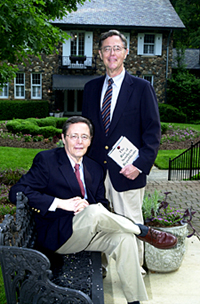 FOR
THE FIRST TIME
in more than half a century, this fall’s elections promise
a genuine tug-of-war between parties for control of Congress,
and an Emory professor says the South is at the epicenter of
this political power struggle. It should come as little surprise
to Southerners that their region’s political landscape
has shifted dramatically in recent years, with the Republican
party making unprecedented gains. Merle Black, Asa G. Candler
Professor of Politics and Government (seated in photo), and
his twin brother, Earl Black, Herbert S. Autrey Professor of
Political Science at Rice University, trace The Rise of Southern
Republicans in their latest book, the last of a trilogy of Southern
political analyses.
FOR
THE FIRST TIME
in more than half a century, this fall’s elections promise
a genuine tug-of-war between parties for control of Congress,
and an Emory professor says the South is at the epicenter of
this political power struggle. It should come as little surprise
to Southerners that their region’s political landscape
has shifted dramatically in recent years, with the Republican
party making unprecedented gains. Merle Black, Asa G. Candler
Professor of Politics and Government (seated in photo), and
his twin brother, Earl Black, Herbert S. Autrey Professor of
Political Science at Rice University, trace The Rise of Southern
Republicans in their latest book, the last of a trilogy of Southern
political analyses.
Once
a staunchly Democratic region, the South has produced an increasingly
more complex mix of voters since the 1960s. The Blacks credit
this transformation largely to what they call the two “Great
White Switches.” Not surprisingly, the brothers write,
“The central political cleavage, as ancient as the South
itself, involves race.”
The
first switch took place in 1964, when Republicans nominated
Arizona Senator Barry Goldwater as their presidential candidate.
Goldwater, who boasted a strongly anti-civil rights record,
attracted scores of racist white voters while virtually severing
the already-tenuous ties between Republicans and African Americans.
In a shift that upset a hundred-year-old apple cart, more Southern
whites voted Republican than Democrat in that election, setting
a new precedent that has held for every presidential contest
since.
The
second switch occurred midway through Ronald Reagan’s presidency.
Up to that point, ex-Union states still shared a political identity
largely carved out more than a hundred years ago by the Civil
War, the Blacks argue. Born in the North to Lincoln and his
ideological successors, the Republican party held sway in the
Northeast, the Midwest, and the West, but the South was solidly
and impenetrably Democratic. In the 1980s, however, more Southern
whites began to identify as Republican rather than Democrat.
“The
growth of the Republican party in the South was stimulated enormously
by the Reagan presidency,” Merle Black said, at a May breakfast
forum hosted by Emory, where he appeared with his brother. “This
was one of the most striking examples of partisan realignment
ever, and it was a huge change for the South. At this point
the Democrats really got religion that they were indeed the
minority party. ‘White conservative Democrat’ became
almost a contradiction in terms.”
Between
them, the Black brothers possess an almost encyclopedic knowledge
of the people, political races, and polling trends that contributed
to Republicans’ recent Southern success. Through colorful
text and graphs they literally chart the party’s remarkable
progress in the South over the last fifty years.
In
1950, for instance, there were no Republican senators and just
two Republican representatives–of 105– from the South
in Congress. In 2000, Republicans made up the majority of the
South’s elected voice in Congress: fourteen of twenty-two
officials in the Senate and seventy-one of 125 in the House.
The
result, says Earl, is that “For the first time in a century,
we have a two-party system that is nationalized. This has tremendous
implications for national politics . . . and the South is the
epicenter of this struggle for control. In the South, either
party is perfectly capable of winning any election in any state.
This is a very competitive situation.”
A
newly competitive South, according the the Blacks, means a newly
competitive nation. Since the Great Depression, Democrats have
reigned supreme in Congress. But this year’s congressional
races guarantee nothing but unpredictability. What this rise
of Southern Republicans means for both regional and national
challenges like race relations, class division, and economic
and political health, only time will tell. –P.P.P.